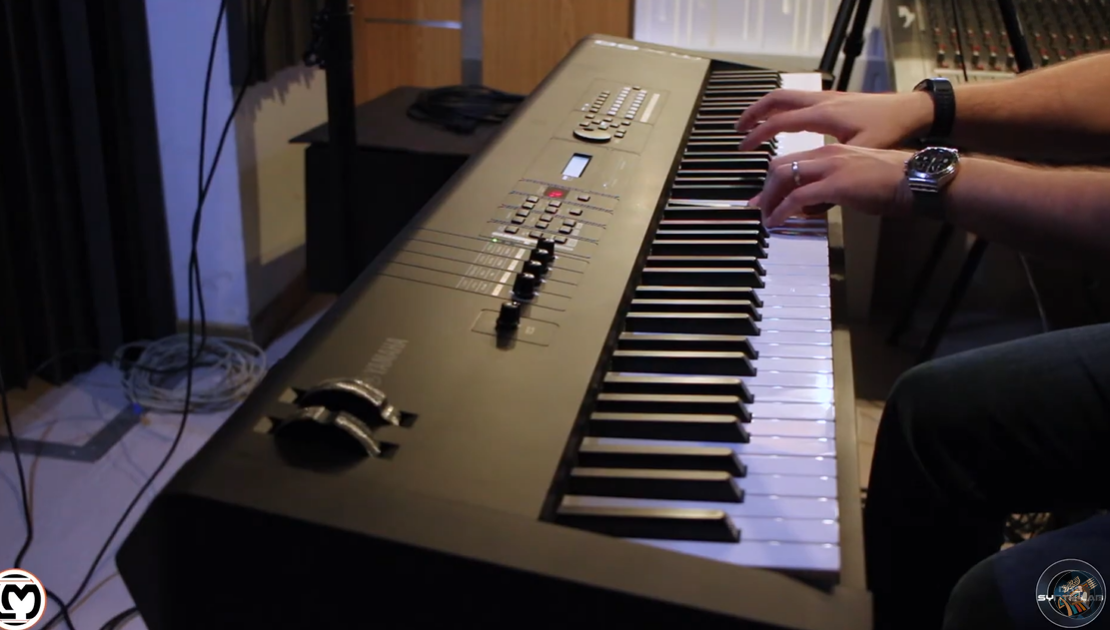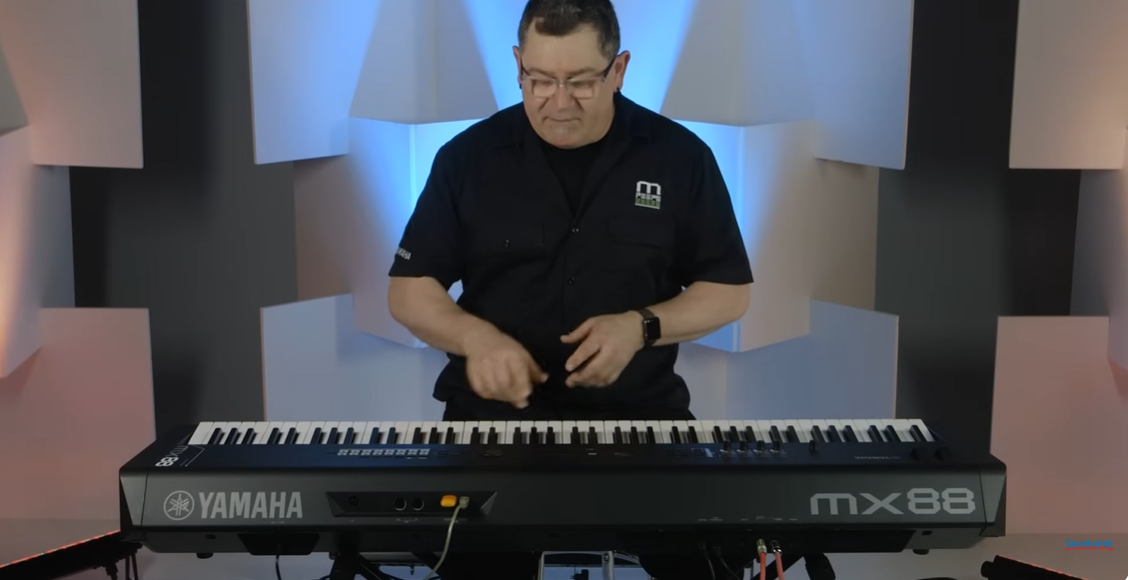Choosing a keyboard isn’t just about the number of keys or how many voices it has. It’s about how it feels under your fingers, how easily it fits into your creative process, and how much it inspires you to keep playing. The Yamaha MX88 is one of those rare instruments that manages to offer the real feel of an acoustic piano, the versatility of a powerful synthesizer, and the portability needed for real-life musicianship—all without a steep price tag.
Launched as part of Yamaha’s respected MX series, the MX88 is designed for pianists, producers, composers, live performers, and even enthusiastic beginners. It combines 88 full-sized graded hammer action keys, over 1,000 high-quality voices from the iconic MOTIF sound engine, built-in effects, and seamless computer and mobile connectivity. Whether you’re practicing at home, producing in the studio, or performing live, this keyboard can do it all—and do it well.
In this in-depth review, we’ll walk through every detail that matters, from build quality and sound engine to connectivity and real-world performance. This isn’t just a spec sheet—this is the complete picture.
Table of Contents
ToggleDesign and Build Quality: A Solid Synth That Looks and Feels Right
When you unbox the Yamaha MX88, the first thing you’ll notice is how sleek, slim, and professional it looks. Despite its full-sized 88-key layout, it doesn’t look bulky or outdated. Its matte black finish gives it a modern and elegant appearance that blends beautifully into any setup—be it a music studio, stage, or living room.
The layout is clean, with intuitively grouped buttons that help you access features quickly without fumbling. The pitch bend and modulation wheels are conveniently placed on the left side, which is standard for live synths and allows for expressive playing during gigs. All controls are solidly built, with no wobbly knobs or buttons that feel like they’ll fall off after a few months.
Even better, despite its lightweight construction, the MX88 doesn’t feel fragile. Yamaha uses high-durability plastic and robust internal components to ensure it can handle frequent movement and long hours of use. This is the kind of instrument that can handle being hauled to rehearsals, studios, or venues again and again.
Materials Used: Lightweight Yet Durable
To make an 88-key synthesizer that’s also portable, Yamaha had to use smart materials. The MX88 features a high-strength plastic casing that is light but strong, with reinforced edges and rubber feet for extra stability. The keys themselves are made from high-grade plastic, designed to simulate the feel of real piano keys while keeping overall weight down. Buttons are tactile and clicky in a satisfying way, while the sliders and knobs feel durable enough for heavy studio or live use.
It’s obvious Yamaha carefully chose every material to balance portability, durability, and comfort. Even after hours of playing, it still feels comfortable, and its quality construction inspires confidence every time you sit down at it.
Portability: Your Full-Sized Studio on the Go
Now, let’s talk portability—because this is where the MX88 really stands out from other 88-key synths. At just 30.6 pounds (13.9 kg), it’s incredibly lightweight for a full-size keyboard. Most keyboards with graded hammer action and 88 keys are much heavier, making them a pain to move around.
But with the MX88, you can easily take it to gigs, rehearsals, recording sessions, or even just move it from room to room. It fits comfortably in a soft gig bag or hard case and will fit in most car trunks without needing to fold down your seats. Whether you’re a touring musician or just someone who needs flexibility, this level of portability is a huge advantage.
Keyboard and Action: Piano-Like Feel That Inspires Practice and Performance
If you’re coming from an acoustic piano background, you’ll feel right at home on the Yamaha MX88. It features Yamaha’s Graded Hammer Standard (GHS) action, which means the low keys feel heavier and the high keys feel lighter—just like a real grand piano. This subtle detail makes a huge difference in expressiveness, especially if you’re playing classical, jazz, or film music.
The keys are also touch-sensitive, meaning they respond to how hard or soft you press them. This gives you the ability to add real emotion and dynamics to your playing. Whether you’re playing soft passages or bold chords, it responds beautifully.
Even better, the GHS action also helps build finger strength and technique, which is important for beginners and advanced players alike. If you’re using this keyboard to learn or teach piano, you can rest assured that it’s building the right skills and habits.
Sound Engine and Voice Selection: The Legendary MOTIF Comes to Life
One of the MX88’s biggest selling points is its MOTIF-based sound engine. If you’re not familiar, the MOTIF series is one of Yamaha’s flagship workstation synth lines, known for incredibly rich, layered, and professional-grade sounds. The MX88 inherits over 1,000 voices from this series, making it one of the best-sounding keyboards in its class.
You get a full Concert Grand Piano sound that is rich and expressive from top to bottom, with deep bass and sparkling treble. But beyond the piano, you also get:
-
Electric pianos with vintage vibes and realistic amp modeling
-
Strings and orchestral layers for film scoring and ambient music
-
Pads and synth textures for electronic music and modern pop
-
Brass, choirs, leads, basses, guitars, and more for every genre imaginable
Each sound can be layered, split, or zoned, allowing you to build complex patches like piano and strings, or bass on the left hand with electric piano on the right.
Connectivity and I/O: Your Music Hub
The MX88 is not just a standalone instrument—it’s a full production hub. It includes:
-
USB Audio and MIDI (Class-compliant): No drivers needed; just plug into your computer or iOS device.
-
Stereo 1/4″ line outputs: For connecting to mixers or speakers.
-
Headphone output (3.5mm jack): Practice quietly any time.
-
Sustain and expression pedal jacks
-
MIDI In/Out ports
-
Aux input: Plug in your phone or MP3 player and jam along with your favorite tracks.
This makes the MX88 perfect for both live and studio setups. You can record clean, stereo audio directly into your DAW or iOS app and control virtual instruments using its MIDI capabilities.
User Interface and Display: Simple Yet Effective
The control panel of the MX88 may not look as flashy as some touchscreen-heavy workstations, but it’s simple, responsive, and easy to navigate. The LCD screen displays voice names, utility settings, and performance modes clearly, even in dim lighting. The 3-digit LED indicator is handy for showing tempo or patch numbers.
Everything is logically grouped, so you’re never more than a button or two away from the function you need. Even beginners can get comfortable with it in no time.
Built-in Effects and Virtual Circuitry Modeling: Studio Magic at Your Fingertips
One of the standout features of the MX88 is VCM (Virtual Circuitry Modeling), which simulates classic analog studio gear right down to the individual circuits. The result is a set of incredibly warm, character-rich effects like chorus, phaser, EQ, flanger, distortion, and vintage amp simulations.
These effects add real color and flavor to your sound, whether you’re using them on piano patches, synth leads, or guitar voices. There’s also a suite of global effects, including reverb and delay, which can be customized for live or studio use.
Recording and Studio Use: Ready for Any Workflow
The MX88 is a dream machine for producers. Since it’s class-compliant, it works with DAWs like Cubase, Ableton, Logic, and FL Studio right out of the box. You can record MIDI and audio simultaneously, making it a true all-in-one recording keyboard.
The included Cubase AI software and compatibility with FM Essential and Cubasis LE2 for iOS means you can start recording, arranging, and mixing right away—even from your iPhone or iPad.
Live Performance: Stage-Ready and Reliable
Whether you’re in a worship band, a wedding gig, or a pop tour, the MX88 has your back. The sound switching is fast and reliable, the keybed is expressive, and it’s easy to tweak sounds in real-time with onboard knobs and controls. You can layer and split sounds instantly, and its lightweight build makes setup and teardown quick and painless.
👍 Pros and Cons
✅ Pros
-
Full 88-key GHS weighted action for real piano feel
-
Over 1,000 MOTIF-derived voices
-
Lightweight and portable
-
Seamless USB Audio/MIDI connectivity
-
VCM effects simulate vintage gear
-
Works with Cubase, iOS, and most DAWs
-
High build quality despite being lightweight
❌ Cons
-
No internal sequencer or sampler
-
Display is basic (non-color, non-touch)
-
Editing deeper synth parameters requires external software
Final Verdict: A Top-Tier Keyboard for the Modern Musician
The Yamaha MX88 is more than just a digital piano or a synth—it’s a powerful, portable, and inspiring instrument that suits both live performers and studio musicians. It brings together Yamaha’s deep experience in piano craftsmanship and synth design into one compact, affordable, and reliable keyboard.
Whether you’re a pianist wanting realistic feel, a producer who needs professional sounds, or a performer who needs power on stage without the weight, the MX88 is the perfect all-rounder. For the price, the value it delivers is outstanding—and it’s built to grow with you as you evolve as a musician.

Frequently Asked Questions
Is the Yamaha MX88 good for beginners?
Yes, absolutely! While the Yamaha MX88 offers advanced features that professionals love, it’s also a fantastic choice for beginners who want to grow with their instrument. Its GHS weighted action mimics the feel of a real piano, which helps new players develop proper finger technique right from the start. Plus, with over 1,000 built-in voices, it makes learning exciting and creative. In this Yamaha MX88 Review, we found that it strikes the perfect balance between ease of use and room to grow.
Can the Yamaha MX88 be used for live performances?
Definitely. The Yamaha MX88 was built with performers in mind. It’s lightweight enough to take on the road (only about 30 pounds), and its fast sound switching, layering, and real-time control knobs make it ideal for live shows. Whether you’re playing in a worship band, a jazz trio, or a pop act, the MX88 delivers professional-level sound without requiring a truckload of gear. In fact, many players praise its reliability and stage-ready design in every Yamaha MX88 review we’ve seen.
Does the Yamaha MX88 work with DAWs like Cubase or Logic?
Yes, the Yamaha MX88 is class-compliant, which means it works with almost all major DAWs, including Cubase, Logic Pro, Ableton Live, and FL Studio, right out of the box—no driver installation needed. It comes with Cubase AI and supports iOS integration too. The ability to send and receive MIDI and stereo audio through USB makes it a powerful tool for music production. As mentioned in this Yamaha MX88 review, it’s a studio-ready keyboard that blends traditional feel with modern tech.
Are there any limitations or downsides to the Yamaha MX88?
While the Yamaha MX88 is an outstanding keyboard overall, it’s not without its minor drawbacks. For example, it doesn’t include an onboard sequencer or sampler, so you’ll need to use external software for those functions. Also, the display is basic, with no touchscreen or color graphics, which might feel dated to users familiar with high-end workstations. That said, as discussed throughout this Yamaha MX88 review, the strengths—like key feel, sound quality, and portability—far outweigh these minor limitations.
Conclusion
The Yamaha MX88 impresses with its powerful features and great sound quality. It suits both beginners and experienced musicians. The keys feel realistic and responsive. This keyboard offers many sound options. It is also portable and easy to use. The MX88 provides excellent value for its price.
Consider it for your next instrument. You won’t be disappointed with its performance and versatility. Enjoy creating music with the Yamaha MX88.



